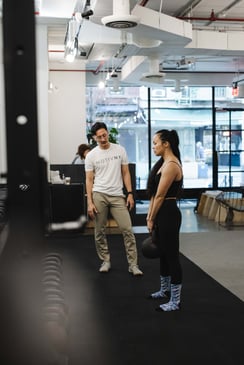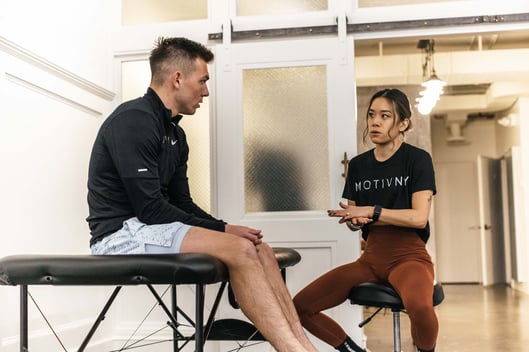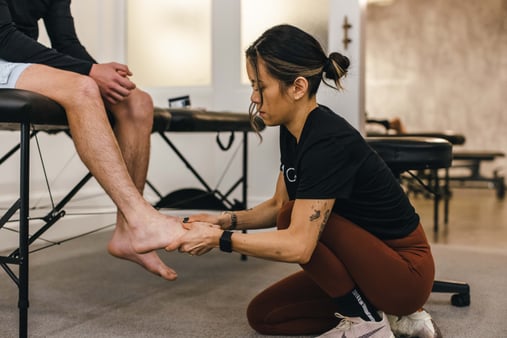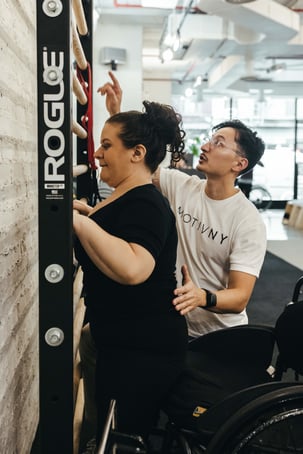I’m Not Injured: Is Physical Therapy For Me?
May 25, 2022
Most physical therapy is prescribed after having been injured, but what if you could prevent yourself from being injured in the first place?

Preventative treatment, often called Prehab, is like getting a physical with your PCP. Through blood test, a physical examination, and talking about your general health, you and your doctor ensure you're as healthy as possible.
A prehab visit with a PT accomplishes much the same thing. Instead of blood tests, It involves an assessment of your body and its strengths and weaknesses, identification of limitations in your training, and education on strategies for avoiding injury.Do you see now how a checkup with a PT can be as beneficial and critical to long term health and performance as a physical with a doctor?
ANATOMY OF A PREHAB VISIT
 At the end of a PT visit, especially a PREHAB visit, an athlete should walk out the door armed with a minimum of three things.
At the end of a PT visit, especially a PREHAB visit, an athlete should walk out the door armed with a minimum of three things.
- A better understanding of your body and its characteristics.
- A clear picture of how your daily activities and circumstances can influence your body and interview with your training.
- A plan for how to address any functional or environmental limitations that could cause injury or delay reaching their goals.
This kind of information not only helps you stay injury free, but it also helps to focus your training and get you to your goals more efficiently.
THE ASSESSMENT

The assessment is the most important part of a physical therapy visit. First, your PT will gather information from you about your exercise routines, goals, injury and medical history, and listen to any concerns you have about your body.
Our goal as healthcare professionals is to understand your relationship with your body and what you expect out of it.
Your therapist will then put you through a movement assessment. This assessment ranges from global movements like squatting to specific measurements like joint mobility and flexibility. Based on your story, they may look at specific areas of your body to try to understand why it functions the way it does.
Let's say you're a Crossfitter who is struggling with their snatches. Your therapist may start looking at your overhead squat to see whether it’s your ankles not flexing enough to keep you balanced, or whether your spinal mobility is hindering your ability to get the weight overhead.
If you are a runner with a history of calf strains and foot pain, your therapist may look at the tread wear on your shoes or ask you to do a step up to determine whether you are striking the ground inappropriately or if your hips and knees are not doing enough of the work.

By the end of the assessment, your PT has gathered information about:
- Your body’s structural and functional strengths and limitations, like how strong your hips are
- The stresses your body goes through day to day, and what you do (or don’t do) to recover
- Your training goals, and the obstacles you are encountering in meeting them.
Now, the fun begins!
THE PREHAB
Prehab is simply the adjustments you make to your training program in order to stay healthy while reaching your goals. Your prehab will look different than anyone else's because it is specifically designed around the information your therapist has gathered about you in the assessment.
If the therapist sees that you have issues with flexibility or motor control of specific joints, they will prescribe you exercises to improve those problem areas. If you struggle with stress or getting enough sleep, your therapist may show you breathwork routines or direct you to resources to help you recover better.

Let’s go back to that Crossfitter with snatch struggles. The PT notices that the athlete’s thoracic spine does not extend enough to comfortably hold a barbell overhead, and that her shoulders are hypermobile and unstable. The athlete admits that she slumps in a chair all day while working 10 hour workdays.
The PT explains that since her thoracic spine is not doing its job, her shoulders are overreaching to make the snatch happen anyway, and that could lead to shoulder injuries down the road. The PT shows her thoracic mobility exercises to do throughout her workday, and shoulder stabilization exercises to do as her Crossfit warmup.
Conclusion
To wrap this up, it should be mentioned that no matter how prepared you are, injuries happen. As long as there are potholes in the world, ankle sprains (and flat tires) are inevitable. But aside from the unpredictable, identifying risks and dealing with them is the smartest way to safely and confidently chase after your training goals, and that starts with talking to a physical therapist.
It's a major flaw in our healthcare system that most insurances will not even approve payment for PT unless there is proof that a person is functionally limited due to an injury. As an out of network provider, we are able to help athletes of all levels optimize their bodies and stop injuries before they even happen.
(for more on why cash pay/out of network service is right for you, check out this article)

Jessica Hartnett
Doctor of Physical Therapist and self-proclaimed adrenaline junkie.
jess@motivny.com